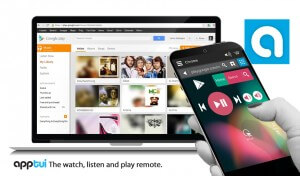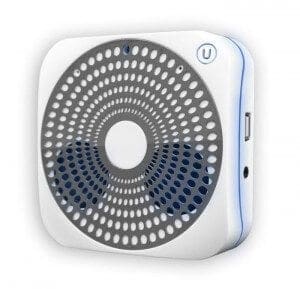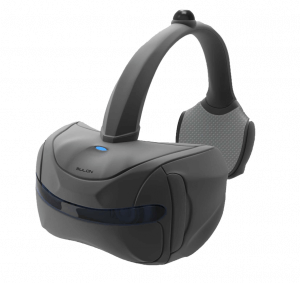A Game of Homes: Communication, cooperation and entertainment in the connected world
July 17, 2014
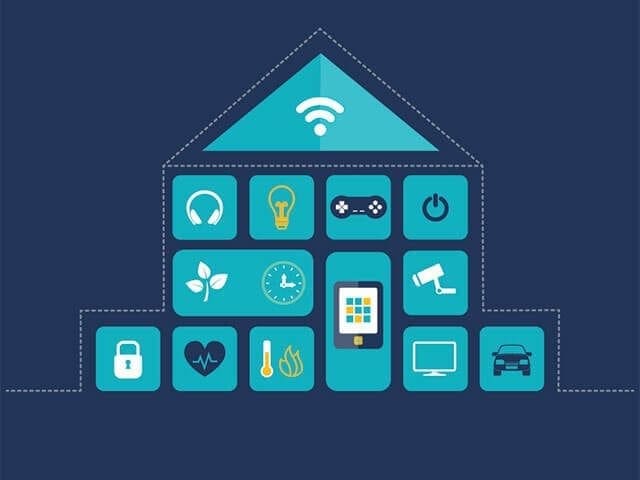
This is the second report in the Connected World Market Insights Series.
The connected world is coming
With the advent of the connected world, your floor will sense when you’ve rolled out of bed and started walking toward the bathroom. The lights in your hallway will turn on as you approach. Your shower will automatically turn on and set the water to your preferred temperature. Once you’ve finished your shower and first cup of coffee, the house will tell your car to start and tune to your favourite morning talk show.
It may seem unbelievable, but this type of technology for the connected home is already being developed and tested. However, don’t expect a suave voice to greet you and control your home in the way of Iron Man’s J.A.R.V.I.S. system or the HAL 9000 just yet.
[inlinetweet prefix=”” tweeter=”” suffix=””]According to Gartner Research, the number of connected devices in the world will reach upwards of 26 billion by 2020[/inlinetweet].1 This will mean more than three connected devices for each person on the planet. There are some who even estimate that this number is too conservative and the real number will be closer to 100 billion.2 These devices will include smartphones, tablets, PCs, televisions, gaming consoles, household appliances, cars and more. The price of these technologies is steadily declining and they are becoming accessible to people all over the world.
These numerous devices will be able to communicate and cooperate with each other and their human controllers through a variety of ways, including built-in WiFi and sensors. With all these ingredients being combined, together we are creating the perfect recipe for the connected world (sometimes better known as the Internet of Things). The way the world is heading, we will soon have everything in our lives connected in one way or another.
If the goal is to connect the world, then what better place to start than the home?
Your home, connected
Forerunners of the connected home have been available for quite some time. As an undergraduate student in 2008, I remember being amazed to discover that I could control the music playing on my laptop through a free download app on my smartphone. Think of the time I could save by not having to walk across the room to change my roommate’s questionable taste in music! In turn, smartphones and tablets are quickly becoming the universal remotes of home entertainment. These types of applications are examples of the connected home in its simplest form.
See Figure 1 for a look at how the connected home might look.
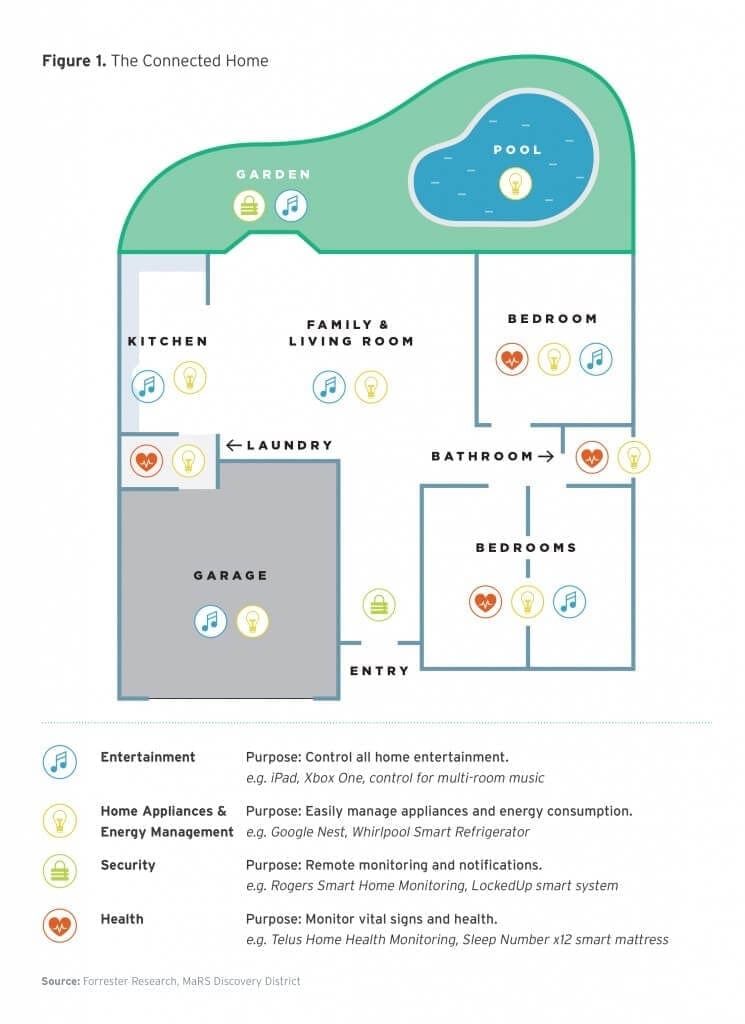
2014 has seen a major increase in the awareness and advancement of the connected home. In January 2014, Google acquired the startup Nest Labs (a smart thermostat and smoke detector company) for $3.2 billion.3 In early June, at the Apple Worldwide Developers Conference, Apple announced the introduction of its HomeKit as a means to control the platform that would connect all users’ smart devices in the home.4 These two players are among the largest, most powerful companies in the world. If they are focusing efforts on the home, you can be sure others are as well.
Two key aspects concerning the connected home of the future will be its ability to monitor your health and energy consumption. Today, smart devices can track your exercise and food intake to ensure maximum health. The connected home holds promise to be particularly helpful to the elderly and those living with disabilities, with respect to safety monitoring, alert systems and independent living.
As far as energy consumption is concerned, smart meters could one day monitor and provide real-time updates on your energy usage, or send you notifications when electricity is cheapest or even automatically adjust.
Health and energy consumption will play a significant role in the connected home and will be explored in depth in future MaRS reports. This report focuses on what the home is mainly used for, beyond shelter: entertainment, rest and relaxation. According to Frost & Sullivan, the media and [inlinetweet prefix=”” tweeter=”” suffix=””]entertainment area of the connected home will grow exponentially from $21.2 billion in 2012 to $76.9 billion by 2020[/inlinetweet].5
Apptui
What exactly does Apptui do? Apptui lets you control your computer with your smartphone or tablet. It is an all-in-one remote that lets you watch, listen and play with your PC and Mac. In addition to that, our platform automatically switches controls depending on the site or app you are using. Apptui currently supports remotes for Netflix, 8tracks, VLC, YouTube and a number of others. We offer a remote for people who have two screens in their lives (smartphone and computer) and want to kick back with their friends, sit on the couch and watch some Netflix, for example. Who are your main clients and/or target market? We want to attract B2B and others who are working to engage the way that people view entertainment in new ways. We’re looking at the Bell Medias or the YouTubes of the world to help them with this engagement. We offer a bridge technology that allows for a new form of interaction with users with the hopes of engaging them for longer.
Where do you see Apptui in one to two years? I see us continuing to actively build upon our user base and striking more B2B deals. We’ve been seeing a 25% to 30% conversion rate off of our homepage, which is great. However, I’ve learned over the years that everything is dependent on what comes next, which is in turn dependent on what comes after that. We are certainly trying to remain focused on our core strategy of trying to monetize our B2B, but we also know that we have to remain flexible. We need to be able to alter the technology or tweak the product depending on what comes next. What major trends or changes have you noticed in your sector? I think one of the things that plagues the whole industry is everyone trying to do too much at the same time. A lot of them end up spreading this huge net, but can’t really deliver properly on any of it. There are a ton of platforms just sitting out there but most of them don’t have any content behind them. We are trying to approach matters by going directly to where the content is and manipulating how you interact with it. |
The Canadian ecosystem
The connected home ecosystem in Canada involves many players striving to claim their share of the market. These stakeholders range from major telecommunications companies (such as Rogers with its Smart Home Monitoring solution) to small app developers. Please see the figure below for examples of some major players involved in the Canadian connected home.
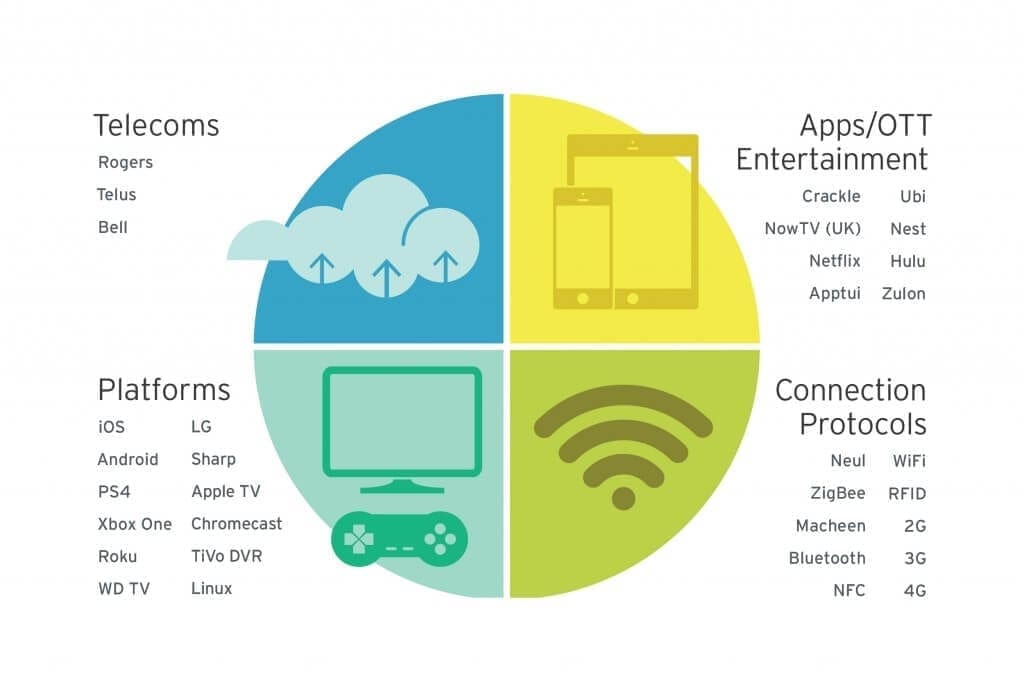
Can you hear me now?
The ability to communicate is a critical feature of the connected home. You could have access to a multitude of amazing smart devices in your home, but unless they can connect, talk and work with each other, then they are no more effective than the “dumb” devices in use today. Forrester Research describes this constraint: “94Fifty’s Bluetooth basketball can sense dribble force and shot angle. Nike Hyperdunk Plus basketball shoes can tell you how fast you’re running… the Under Armour E39 shirt knows your heart rate… But you could be using all three of these devices at the same time, and they wouldn’t even know they were playing the same game… the data they collect is siloed into their own separate app.”6
While this example relates to wearable sensors, it illustrates the same issue faced by smart devices. That is, many of the big companies simply don’t play well with others.
“Consumers like to have choices and will demand that closed systems learn to communicate with each other.”
– Karen Bartleson, President of the IEEE-SA
Generally, devices are getting smarter and are loaded with sensors that are able to capture more complex data sets. But a deep fragmentation exists in the market thanks to the separate ecosystems built by competing organizations (e.g., Apple versus Google). Many companies are trying to bridge this gap through different platforms and APIs, but they are not yet reaching enough consumers, or developers to build new applications.
Furthermore, until industry standards are established, the connected home will be a blend of some devices communicating and others completely ignoring each other. Karen Bartleson, president of the Institute of Electrical and Electronics Engineers Standards Association, known as the IEEE-SA, has stated, “We could see a few large ecosystems emerge for [the connected world], such as we have today with Android, iOS and Windows. But consumers like to have choices and will demand that closed systems learn to communicate with each other.”7
Compatible connected devices are currently talking through WiFi, Bluetooth or sensors. However, two big names striving to create and control the new standard of communication for the connected home are ZigBee and Z-Wave. Both of these use wireless networking to allow devices from different makers to talk to one another. As it stands, neither of these has been wholly accepted by large manufacturers of connected devices, most of whom would prefer to develop their own networks.
Another project by Qualcomm called AllJoyn is developing a system to allow products, apps and services to communicate through WiFi, power lines or Ethernet, regardless of their manufacturer or operating system.8 The project is still in development but has already brought LG, Panasonic and, most recently, Microsoft on board, and could end up being a major game changer in advancing the connected home.9
The hubs
Another strategy to overcome the communication gap between technologies is the creation of a “middle man,” or hub device. This hub device is meant to act as a neutral relay between different types of smart devices. Think of a hub as the Switzerland of the connected world. For example, Quirky, a New York-based invention company, has developed a hub, Wink, which strives to unite diverse gadgets into a single ecosystem. This hub has enlisted major players such as General Electric, Honeywell and Philips to join.10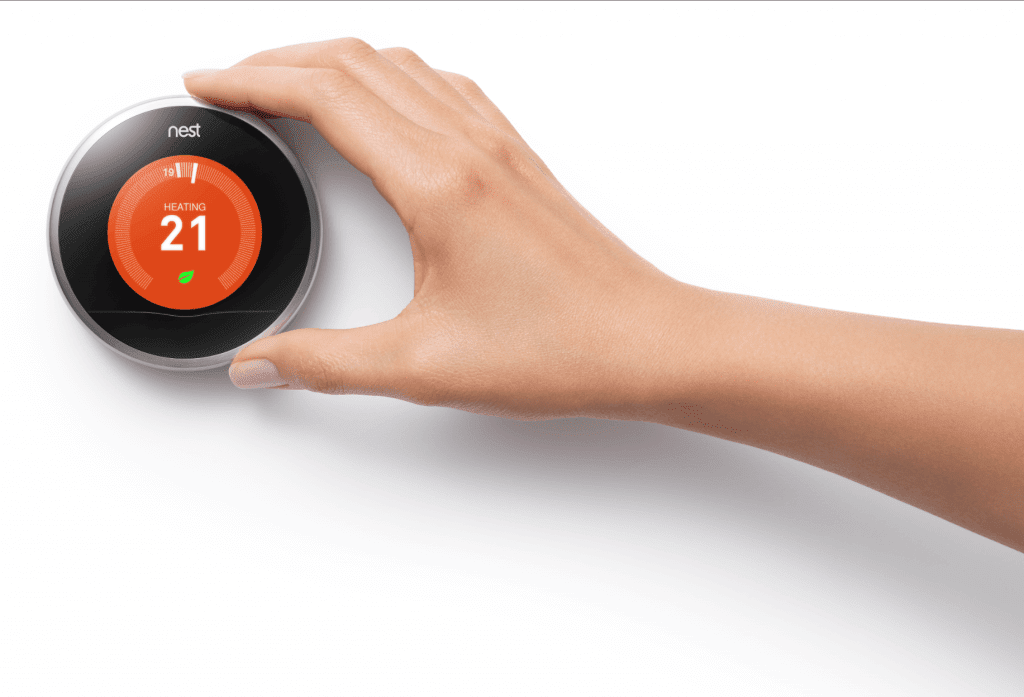
But where would we be without a little healthy competition? In 2014, Google’s Nest announced its “Works with Nest” program. This program plans to seamlessly bridge the divide between different connected gadgets. The program has already recruited home appliance heavyweights such as Logitech, Chamberlain, Whirlpool and even Mercedes-Benz.11 Not to be outdone, Apple’s HomeKit plans to allow third-party developers to sync their devices and apps and be controlled by an iPhone or iPad.
The connected home will not be widely adopted until we have a user-friendly system that easily allows customers to access all their devices, regardless of manufacturer or operating system. This task is much easier said than done and the battle for the connected home is setting up to be a long and messy one.
Ubi: The Ubiquitous Computer
What exactly does your company do? We have created a platform that allows for interaction between devices connected to the Internet and Internet services through voice and natural language. The first product we developed is called the Ubi, which stands for ubiquitous computer. The voice-operated computer plugs into a wall outlet and makes the environment around it Internet-enabled. With that, you’re able to interact with your home, or your home automation devices and services. This includes sending messages, setting your calendar, turning the lights on and off, and so on. Who are the main clients and/or target markets for the Ubi? We are essentially sitting in the middle of two converging markets. One is the home automation market and the other is the voice and natural language interaction market. Those looking to use the Ubi today typically use other home automation devices and services and the Ubi enables them add a voice layer to these services. We have shipped more than 2,000 units to these early adopters. Where do you see your company in one to two years? These days we’re working on the next generation of the product with the aim to completely transform how people interact with the technology. We want users to walk into a room and literally talk to their environment. So, we want to create an immersive, structured computer that is essentially camouflaged within your home or office. Ubi chimes in when it’s needed and then fades into the background when you aren’t using it. We are encouraging developers to create applications for the Ubi to broaden its reach. One of the main features of this platform is the ability to expand functionality, applications and services. For example, home monitoring or even health and medical applications are all possible. What are some major trends you have noticed in this sector? One of the trends we have noticed is that a lot of products and services in this sector are focusing on the learning aspect of the technology. Most of the products we use today allow us to set our own personal preferences, and then note our behaviour to learn and adapt. For example, a system will recognize that every morning when you wake up you ask what the weather is like. Using the learning feature, the moment the system recognizes you’re awake, it will tell you the day’s weather. The ability for devices to learn and adapt is a major trend. |
The entertainment centre of the home
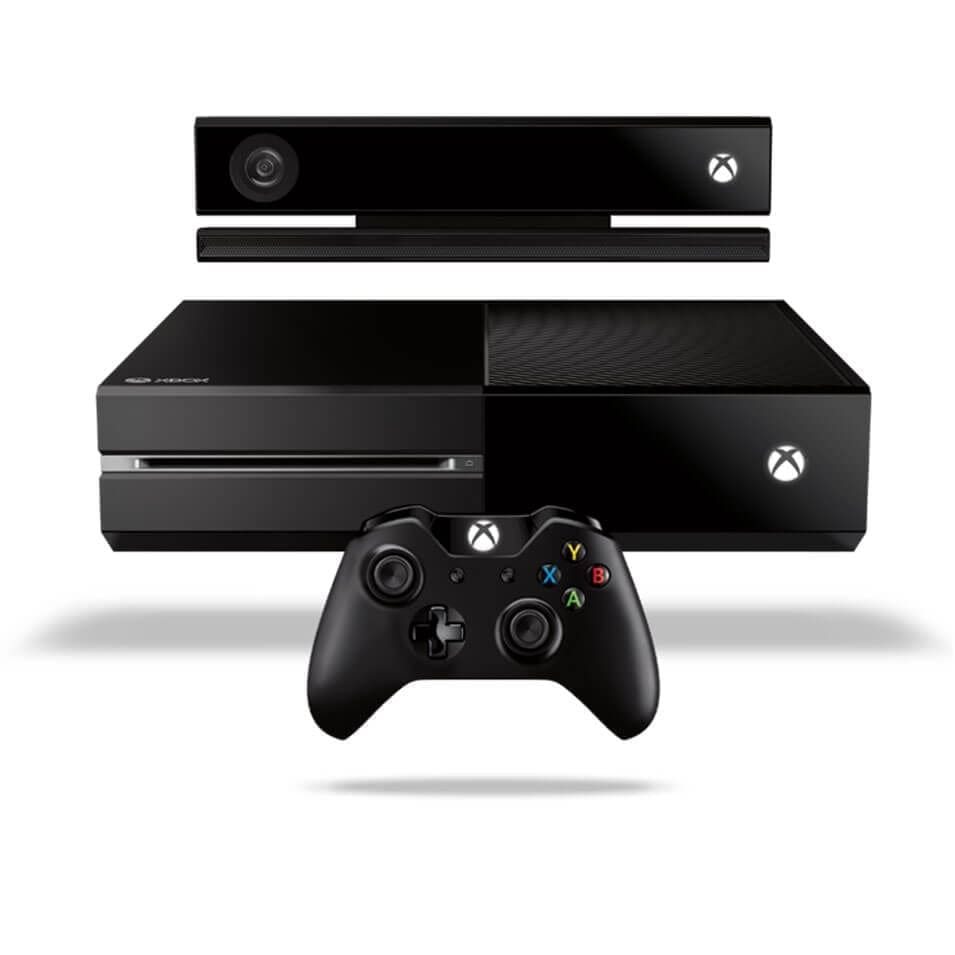
The introduction of the universal remote changed the way people interacted with their home entertainment systems. The device allowed users to control their television, DVD player and cable box without the constant searching for, setting down and picking up of separate remotes. With the progression of technology, consumers want even more flexibility and control for their entertainment devices. Enter the eighth generation of video game consoles.
The past decade has seen video games rise rapidly in the ranks of the entertainment industry. One only need look at blockbuster games such as Grand Theft Auto V, which earned over a billion dollars in the first three days, to see that they now rival major motion pictures in terms of popularity and revenue.12
In the past, social stigma surrounded video games, with the perception being that video games were largely designed for kids, teenagers or purposeless middle-aged males. To some extent, this stigma still exists. However, the statistics show that 61% of Canadian households own at least one video game console. And the average age of a Canadian gamer is 31, with 46% being female. In fact, if we include PC/desktop and mobile/handheld gaming, 58% of Canadians would be considered gamers.13 Video games have found their way into most of our lives—and now they are taking aim at controlling the home.
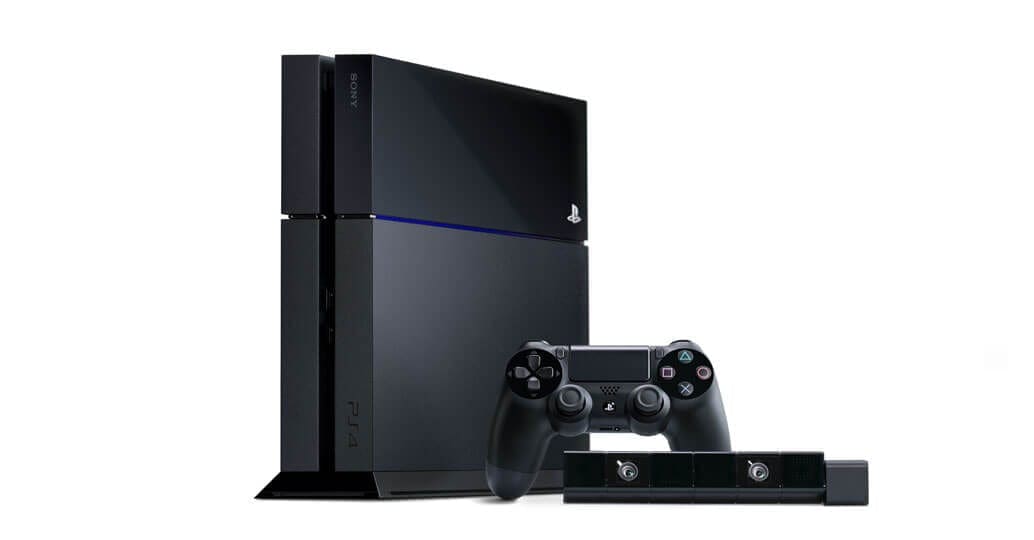
By 2017, the number of worldwide gaming consoles is expected to rise above 207 million, encompassing approximately 133.6 million homes.14 Of this number of households, approximately 84% are expected to take advantage of the online capabilities offered by the consoles for gaming, streaming and communicating.14 The release of the Xbox One, PlayStation 4 (PS4), and to a lesser extent, the Wii U signalled a change in the home entertainment and connectivity industry. The Xbox One and the PS4 in particular are competing to become the home entertainment centre.
The console wars, part VIII
The newest chapter of the console war, which began in November 2013, has seen the PS4 jump out to an early lead. As of April 2014, the Sony console had sold approximately 7 million units, while the Xbox One had sold about 5 million.15 These sale numbers certainly show an advantage for the PS4, but are hardly enough to deem the PS4 a clear winner. Also, the Wii U, which has been on the market since November 2012, has sold approximately 6.2 million consoles.15
One reason for PS4’s lead over Xbox One was the initial price tag. The PS4 was initially released for US$400, whereas the Xbox started at US$500. Microsoft, though, announced that in June 2014 they would begin shipping a new version of their console without the Kinect, a motion-sensing camera that allows users to interact with their Xbox through movement, for the reduced price of US$400.
But beyond the price differential, other factors affected consumer decisions. Microsoft was forced to conduct damage control after a controversy emerged with the introduction of the Xbox One at the Electronic Entertainment Expo (E3) in 2013. The company had to address issues about the always-on camera, the lack of game sharing and the product not being backwards compatible with the Xbox 360. 2014’s E3 saw Microsoft change gears and focus on what gamers truly want to hear about: the games. Time will tell if these moves will enable the Xbox One to surmount the gap between its sales and those of its longtime rival.
Microsoft and Sony each believe their consoles have the ability to be the entertainment centre of the home. They aim to replace other game consoles, cable boxes, stereos, DVD/Blu-ray players and more in one fell swoop. Both consoles allow their users to seamlessly watch television and movies, surf the net, talk to friends, stream music and, of course, play a wide range of video games. For instance, Xbox One allows users to easily switch between playing a game and Skyping (see below) with a friend by simply speaking out loud: “Xbox, switch to Skype.”

Sony, meanwhile, is in the process of developing its own virtual reality system, Morpheus (see below), which will allow users to interact with its games in novel ways. While the Morpheus is not yet ready for widespread release, the demonstrations of the system have received widespread praise (particularly one demonstration that involves a deep-ocean run-in with a shark). The possibilities of including virtual reality (VR) in the connected home are nearly limitless (see our profile of Sulon Technologies for more details).
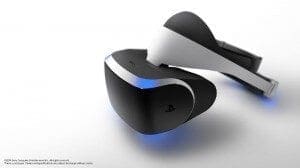
At the same time, video game consoles are competing against other service delivery platforms such as Apple TV, Chromecast, smart TVs and remote apps for iPads. However, while these platforms offer similar content delivery solutions (e.g., Netflix, YouTube, games), the video game consoles have the distinct advantage of being able to offer consumers so much more as well as a far superior experience in terms of gaming. These eighth-generation gaming consoles are, for better or for worse, enabling users to interact with their entire home entertainment experience without getting off the couch.
Same stuff, different package?
Competition can often spur superior products as manufacturers or developers strive to outdo one another. This type of competition between technologies has always existed and, in most cases, it has yielded clear winners and losers. For example, VHS beat out Betamax, Blu-ray defeated HD DVD and the iPod outperformed every other MP3 player on the market. However, no clear winner has as yet emerged from the recent generations of video game consoles, even though the market has only three major players.
“You need powerful companies like Sony and Microsoft to be battling out with each other because it drives investment in their platform. It drives competition.”
– Peter Moore, COO of Electronic Arts
One might think this competition would be challenging for developers who, barring exclusive titles for certain consoles, would need to create different versions of same game for Xbox One, Xbox 360, PS4, PS3, Wii U, PC, smartphones and tablets. But as Peter Moore, COO of Electronic Arts (EA), a major video game developer, points out, “You need powerful companies like Sony and Microsoft to be battling out with each other because it drives investment in their platform. It drives competition… all in all, it becomes healthy for gamers, for the environment. When you have a runaway winner, it actually has a reverse effect.”16
If we examine the Xbox One and PS4, they are essentially the same machine with minor differences. Hardcore fans might argue that the PlayStation has superior graphics or that the Xbox interface is more user friendly, but ultimately, much like Blu-ray and HD DVD, they offer the same experience.
In many ways the competition for the connected home mirrors the one between video game consoles: separate manufacturers who offer very similar experiences but refuse to allow their devices to talk to one another. Given we have seen consoles have come this far with no clear winner, we may well see a similar outcome for the connected home. Unless manufacturers begin to cooperate, consumers could find themselves forced to choose between a Microsoft home, a Google home or an Apple home.
Sulon Technologies
|
Bugs, thugs, and the future
According to Berg Insights, the United States had 3.5 million connected homes at the end of 2012.17 It also projects that the US and Europe together will have approximately 36 million of these homes by 2017. This is a bold prediction considering the difficulties that the connected home is currently experiencing. In May 2014, 440,000 of Google’s Nest Protect fire alarms were recalled after it was discovered that a “waving” feature would completely disable the alarm.18 It has also been revealed that a television advertisement featuring an actor saying “Xbox on” is inadvertently turning on Xbox One consoles inside viewer’s homes.19 Needless to say, a number of bugs need to be fixed before consumers will embrace the connected home.
Security and privacy concerns also pose a major challenge for both the connected home and the Internet of Things. If the entire world is connected, then the risk of someone accessing your private information through a vulnerable appliance in your home, such as a coffee maker, becomes real. Currently, many small home appliances feature little to no security and this leaves them open to attack.20
In the not too distant future, consumers may rail against their smart TV after it displays another unwanted spam message or fear their smart locks will malfunction while they’re at work. The connected home offers amazing opportunities to enrich our lives but security, reliability and cooperation between developers must be ensured before widespread adoption will take place.
[download url=”https://www.marsdd.com/wp-content/uploads/2014/07/MaRS-Whitepaper-ConnectedWorld-AGameofHomes1.pdf” type=”pdf”]A Game of Homes: Communication, cooperation and entertainment in the connected world[/download]
References
1. Middleton, P., Kjledsen, P., & Tully, J. (2013, November 18). Forecast: The Internet of Things, Worldwide, 2013. Gartner Research.
2. Morgan, J. (2014, May 4). A Simple Explanation Of ‘The Internet Of Things’. Forbes. Retrieved from http://www.forbes.com/sites/jacobmorgan/2014/05/13/simple-explanation-internet-things-that-anyone-can-understand/
3. Geschickter, C., & Sumic, Z. (2014, 17 January). Google Enters Connected-Home Market With Nest Acquisition. Gartner Research.
4. Gorman, M. (2014, June). Apple attempts to conquer the connected home. Engadget. Retrieved from http://www.engadget.com/2014/06/03/apple-connected-homekit/?ncid=rss_truncated
5. Vidyasekar, A.D. (2014, April 28). Connected Living: Connected Homes, Work, and Digital Cities to Create a $731.79-billion Market Opportunity by 2020. Frost & Sullivan.
6. Rotman Epps, S. (2013, 17 October). There Is No Internet Of Things—Yet. Forrester Research.
7. Kelly, H. (2014, 28 March). Helping ‘smart’ devices talk to each other. CNN Tech. Retrieved from http://www.cnn.com/2014/03/28/tech/innovation/smart-device-communication/
8. Bertolucci, J. (2014, 15 April). AllJoyn: A Common Language For Internet Of Things. InformationWeek. Retrieved from http://www.informationweek.com/big-data/software-platforms/alljoyn-a-common-language-for-internet-of-things/d/d-id/1204467
9. Randewich, N. (2014, 2 July). How the battle for ‘The Internet of Things’ could be a ‘Blu-Ray vs. HD DVD’ re-run. The Globe and Mail. Retrieved from http://www.theglobeandmail.com/technology/tech-news/the-showdown-over-the-internet-of-things-like-blu-ray-vs-hd-dvd/article19409491/
10. Lohr, S. (2014, 22 June). Quirky to Create a Smart-Home Products Company. The New York Times. Retrieved from http://www.nytimes.com/2014/06/23/technology/quirky-hopes-wink-will-speed-adoption-of-smart-home-products.html?_r=0
11. Burns, M. (2014, 23 June). Google Makes Its Nest At The Center Of The Smart Home. TechCrunch. Retrieved from http://techcrunch.com/2014/06/23/google-makes-its-nest-at-the-center-of-the-smart-home/
12. Crecente, B. (2013, 20 September). Grand Theft Auto 5 hits $1 billion in three days, sets new record. Polygon. Retrieved from http://www.polygon.com/2013/9/20/4752380/grand-theft-auto-5-hits-1-billion-in-three-days-sets-new-record
13. Entertainment Software Association of Canada. (2013). 2013: Essential Facts about the Canadian Video Game Industry. Retrieved from http://theesa.ca/wp-content/uploads/2013/10/Essential-Facts-English.pdf
14. Ward, L. (2013, September). Worldwide Connected Game and Entertainment Console and Connected Smart TV, Microconsole, and Set-Top Box Gaming 2013–2017 Forecast. IDC.
15. Grub, J. (2014, 16 June). May 2014 NPD: PlayStation 4, Xbox One, Watch Dogs, and Mario Kart 8 fuel industry-wide surge. VentureBeat. Retrieved from http://venturebeat.com/2014/06/16/may-2014-npd-ps4-xbox-one-watch-dogs-and-mario-kart-8-fuel-industry-wide-surge/
16. Ohannessian, K. (2014, 30 June). EA’s Peter Moore says console war is ‘good for the industry’. Tech Times. Retrieved from http://www.techtimes.com/articles/9433/20140630/ea-console-war.htm
17. Higginbotham, S. (2014, 27 June). Berg Insights predicts 36M smart homes by 2017. Gigaom. Retrieved from http://gigaom.com/2014/06/27/berg-insights-predicts-36m-smart-homes-by-2017/?utm_content=buffer3092a&utm_medium=social&utm_source=linkedin.com&utm_campaign=buffer
18. Panzarino, M. (2014, 21 May). Recalled Nest Protect Smoke Alarm Will Return To Sale In Weeks. TechCrunch. Retrieved from http://techcrunch.com/2014/05/21/nest-recalls-all-440k-protect-smoke-alarms-but-will-have-them-back-on-the-market-in-weeks/
19. Kelion, L. (2014, 12 June). E3: Xbox One ad is switching on Microsoft consoles. BBC News Technology. Retrieved from http://www.bbc.com/news/technology-27827545
20. The Economist. (2014, 25 January). Spam in the fridge. Retrieved from http://www.economist.com/news/science-and-technology/21594955-when-internet-things-misbehaves-spam-fridge
The Connected World Market Insights Series
The Connected World Market Insights Series will cover such topics as:
- Advanced metering infrastructure (AMI) and smart meters: Building upon a home advantage
- Automation and energy: Unlocking home and building energy management opportunities
- Entertainment for the connected home
- Security: Privacy, data ownership and data risk
- Transforming health: Decentralized and connected care
- Connected mining opportunities and new technologies
- The value of real-time meter data
Accessing data is key, but we think that being able to format and analyze that data is where the real value can be found. During this series, MI will delve into the market opportunity now becoming available due to progress in opening up datasets, and the development of infrastructure and analytics that are creating new services and products and bringing them to market.


